+ Open data
Open data
- Basic information
Basic information
| Entry | Database: PDB / ID: 6xyo | ||||||||||||||||||||||||
|---|---|---|---|---|---|---|---|---|---|---|---|---|---|---|---|---|---|---|---|---|---|---|---|---|---|
| Title | Multiple system atrophy Type I alpha-synuclein filament | ||||||||||||||||||||||||
 Components Components | Alpha-synuclein | ||||||||||||||||||||||||
 Keywords Keywords | PROTEIN FIBRIL / multiple system atrophy / alpha-synuclein filament | ||||||||||||||||||||||||
| Function / homology |  Function and homology information Function and homology informationnegative regulation of mitochondrial electron transport, NADH to ubiquinone / neutral lipid metabolic process / regulation of phospholipase activity / negative regulation of monooxygenase activity / regulation of acyl-CoA biosynthetic process / negative regulation of dopamine uptake involved in synaptic transmission / negative regulation of norepinephrine uptake / positive regulation of glutathione peroxidase activity / positive regulation of SNARE complex assembly / positive regulation of hydrogen peroxide catabolic process ...negative regulation of mitochondrial electron transport, NADH to ubiquinone / neutral lipid metabolic process / regulation of phospholipase activity / negative regulation of monooxygenase activity / regulation of acyl-CoA biosynthetic process / negative regulation of dopamine uptake involved in synaptic transmission / negative regulation of norepinephrine uptake / positive regulation of glutathione peroxidase activity / positive regulation of SNARE complex assembly / positive regulation of hydrogen peroxide catabolic process / supramolecular fiber / negative regulation of transporter activity / mitochondrial membrane organization / negative regulation of chaperone-mediated autophagy / regulation of reactive oxygen species biosynthetic process / positive regulation of protein localization to cell periphery / regulation of synaptic vesicle recycling / negative regulation of platelet-derived growth factor receptor signaling pathway / negative regulation of exocytosis / regulation of glutamate secretion / regulation of norepinephrine uptake / response to iron(II) ion / dopamine biosynthetic process / SNARE complex assembly / positive regulation of neurotransmitter secretion / regulation of locomotion / positive regulation of inositol phosphate biosynthetic process / synaptic vesicle priming / regulation of macrophage activation / dopamine uptake involved in synaptic transmission / negative regulation of microtubule polymerization / synaptic vesicle transport / dynein complex binding / positive regulation of receptor recycling / regulation of dopamine secretion / protein kinase inhibitor activity / negative regulation of thrombin-activated receptor signaling pathway / response to type II interferon / cuprous ion binding / positive regulation of exocytosis / synaptic vesicle exocytosis / kinesin binding / positive regulation of endocytosis / mitochondrial ATP synthesis coupled electron transport / cysteine-type endopeptidase inhibitor activity involved in apoptotic process / response to magnesium ion / regulation of presynapse assembly / synaptic vesicle endocytosis / negative regulation of serotonin uptake / alpha-tubulin binding / localization / phospholipid metabolic process / supramolecular fiber organization / axon terminus / inclusion body / cellular response to copper ion / Hsp70 protein binding / cellular response to epinephrine stimulus / excitatory postsynaptic potential / response to interleukin-1 / adult locomotory behavior / SNARE binding / positive regulation of release of sequestered calcium ion into cytosol / fatty acid metabolic process / long-term synaptic potentiation / regulation of transmembrane transporter activity / phosphoprotein binding / protein tetramerization / synapse organization / microglial cell activation / regulation of long-term neuronal synaptic plasticity / negative regulation of protein kinase activity / protein destabilization / ferrous iron binding / PKR-mediated signaling / negative regulation of cysteine-type endopeptidase activity involved in apoptotic process / tau protein binding / positive regulation of protein serine/threonine kinase activity / receptor internalization / phospholipid binding / synaptic vesicle membrane / positive regulation of inflammatory response / activation of cysteine-type endopeptidase activity involved in apoptotic process / actin cytoskeleton / positive regulation of peptidyl-serine phosphorylation / actin binding / cell cortex / cellular response to oxidative stress / histone binding / growth cone / postsynapse / chemical synaptic transmission / neuron apoptotic process / negative regulation of neuron apoptotic process / amyloid fibril formation / response to lipopolysaccharide / molecular adaptor activity / oxidoreductase activity / lysosome / transcription cis-regulatory region binding Similarity search - Function | ||||||||||||||||||||||||
| Biological species |  Homo sapiens (human) Homo sapiens (human) | ||||||||||||||||||||||||
| Method | ELECTRON MICROSCOPY / helical reconstruction / cryo EM / Resolution: 2.6 Å | ||||||||||||||||||||||||
 Authors Authors | Schweighauser, M. / Shi, Y. / Tarutani, A. / Kametani, F. / Murzin, A.G. / Ghetti, B. / Matsubara, T. / Tomita, T. / Ando, T. / Hasegawa, K. ...Schweighauser, M. / Shi, Y. / Tarutani, A. / Kametani, F. / Murzin, A.G. / Ghetti, B. / Matsubara, T. / Tomita, T. / Ando, T. / Hasegawa, K. / Murayama, S. / Yoshida, M. / Hasegawa, M. / Scheres, S.H.W. / Goedert, M. | ||||||||||||||||||||||||
| Funding support |  United Kingdom, United Kingdom,  Japan, Japan,  United States, 7items United States, 7items
| ||||||||||||||||||||||||
 Citation Citation |  Journal: Nature / Year: 2020 Journal: Nature / Year: 2020Title: Structures of α-synuclein filaments from multiple system atrophy. Authors: Manuel Schweighauser / Yang Shi / Airi Tarutani / Fuyuki Kametani / Alexey G Murzin / Bernardino Ghetti / Tomoyasu Matsubara / Taisuke Tomita / Takashi Ando / Kazuko Hasegawa / Shigeo ...Authors: Manuel Schweighauser / Yang Shi / Airi Tarutani / Fuyuki Kametani / Alexey G Murzin / Bernardino Ghetti / Tomoyasu Matsubara / Taisuke Tomita / Takashi Ando / Kazuko Hasegawa / Shigeo Murayama / Mari Yoshida / Masato Hasegawa / Sjors H W Scheres / Michel Goedert /    Abstract: Synucleinopathies, which include multiple system atrophy (MSA), Parkinson's disease, Parkinson's disease with dementia and dementia with Lewy bodies (DLB), are human neurodegenerative diseases. ...Synucleinopathies, which include multiple system atrophy (MSA), Parkinson's disease, Parkinson's disease with dementia and dementia with Lewy bodies (DLB), are human neurodegenerative diseases. Existing treatments are at best symptomatic. These diseases are characterized by the presence of, and believed to be caused by the formation of, filamentous inclusions of α-synuclein in brain cells. However, the structures of α-synuclein filaments from the human brain are unknown. Here, using cryo-electron microscopy, we show that α-synuclein inclusions from the brains of individuals with MSA are made of two types of filament, each of which consists of two different protofilaments. In each type of filament, non-proteinaceous molecules are present at the interface of the two protofilaments. Using two-dimensional class averaging, we show that α-synuclein filaments from the brains of individuals with MSA differ from those of individuals with DLB, which suggests that distinct conformers or strains characterize specific synucleinopathies. As is the case with tau assemblies, the structures of α-synuclein filaments extracted from the brains of individuals with MSA differ from those formed in vitro using recombinant proteins, which has implications for understanding the mechanisms of aggregate propagation and neurodegeneration in the human brain. These findings have diagnostic and potential therapeutic relevance, especially because of the unmet clinical need to be able to image filamentous α-synuclein inclusions in the human brain. | ||||||||||||||||||||||||
| History |
|
- Structure visualization
Structure visualization
| Movie |
 Movie viewer Movie viewer |
|---|---|
| Structure viewer | Molecule:  Molmil Molmil Jmol/JSmol Jmol/JSmol |
- Downloads & links
Downloads & links
- Download
Download
| PDBx/mmCIF format |  6xyo.cif.gz 6xyo.cif.gz | 131.2 KB | Display |  PDBx/mmCIF format PDBx/mmCIF format |
|---|---|---|---|---|
| PDB format |  pdb6xyo.ent.gz pdb6xyo.ent.gz | 102.9 KB | Display |  PDB format PDB format |
| PDBx/mmJSON format |  6xyo.json.gz 6xyo.json.gz | Tree view |  PDBx/mmJSON format PDBx/mmJSON format | |
| Others |  Other downloads Other downloads |
-Validation report
| Summary document |  6xyo_validation.pdf.gz 6xyo_validation.pdf.gz | 1.2 MB | Display |  wwPDB validaton report wwPDB validaton report |
|---|---|---|---|---|
| Full document |  6xyo_full_validation.pdf.gz 6xyo_full_validation.pdf.gz | 1.2 MB | Display | |
| Data in XML |  6xyo_validation.xml.gz 6xyo_validation.xml.gz | 37.4 KB | Display | |
| Data in CIF |  6xyo_validation.cif.gz 6xyo_validation.cif.gz | 52.3 KB | Display | |
| Arichive directory |  https://data.pdbj.org/pub/pdb/validation_reports/xy/6xyo https://data.pdbj.org/pub/pdb/validation_reports/xy/6xyo ftp://data.pdbj.org/pub/pdb/validation_reports/xy/6xyo ftp://data.pdbj.org/pub/pdb/validation_reports/xy/6xyo | HTTPS FTP |
-Related structure data
| Related structure data |  10650MC  6xypC  6xyqC M: map data used to model this data C: citing same article ( |
|---|---|
| Similar structure data | |
| EM raw data |  EMPIAR-10357 (Title: CryoEM dataset of sarkosyl-insoluble fractions from the putamen of multiple system atrophy brain of case 1 EMPIAR-10357 (Title: CryoEM dataset of sarkosyl-insoluble fractions from the putamen of multiple system atrophy brain of case 1Data size: 3.2 TB Data #1: Unaligned multi-frame movies [micrographs - multiframe] Data #2: Dose-weighted aligned micrographs [micrographs - single frame] Data #3: Polished particle stacks [picked particles - single frame - processed]) |
- Links
Links
- Assembly
Assembly
| Deposited unit | 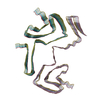
|
|---|---|
| 1 |
|
- Components
Components
| #1: Protein | Mass: 14476.108 Da / Num. of mol.: 10 / Source method: isolated from a natural source / Source: (natural)  Homo sapiens (human) / References: UniProt: P37840 Homo sapiens (human) / References: UniProt: P37840 |
|---|
-Experimental details
-Experiment
| Experiment | Method: ELECTRON MICROSCOPY |
|---|---|
| EM experiment | Aggregation state: FILAMENT / 3D reconstruction method: helical reconstruction |
- Sample preparation
Sample preparation
| Component | Name: Sarkosyl-insoluble fractions from the putamen of multiple system atrophy brain Type: TISSUE / Entity ID: all / Source: NATURAL |
|---|---|
| Source (natural) | Organism:  Homo sapiens (human) Homo sapiens (human) |
| Buffer solution | pH: 7.4 |
| Specimen | Embedding applied: NO / Shadowing applied: NO / Staining applied: NO / Vitrification applied: YES |
| Vitrification | Cryogen name: ETHANE |
- Electron microscopy imaging
Electron microscopy imaging
| Experimental equipment |  Model: Titan Krios / Image courtesy: FEI Company |
|---|---|
| Microscopy | Model: FEI TITAN KRIOS |
| Electron gun | Electron source:  FIELD EMISSION GUN / Accelerating voltage: 300 kV / Illumination mode: FLOOD BEAM FIELD EMISSION GUN / Accelerating voltage: 300 kV / Illumination mode: FLOOD BEAM |
| Electron lens | Mode: BRIGHT FIELD |
| Image recording | Electron dose: 49.2 e/Å2 / Film or detector model: GATAN K3 (6k x 4k) |
- Processing
Processing
| Software | Name: PHENIX / Version: dev_3580: / Classification: refinement | ||||||||||||||||||||||||
|---|---|---|---|---|---|---|---|---|---|---|---|---|---|---|---|---|---|---|---|---|---|---|---|---|---|
| CTF correction | Type: PHASE FLIPPING AND AMPLITUDE CORRECTION | ||||||||||||||||||||||||
| Helical symmerty | Angular rotation/subunit: -1.44 ° / Axial rise/subunit: 4.72 Å / Axial symmetry: C1 | ||||||||||||||||||||||||
| 3D reconstruction | Resolution: 2.6 Å / Resolution method: FSC 0.143 CUT-OFF / Num. of particles: 120501 / Symmetry type: HELICAL | ||||||||||||||||||||||||
| Refine LS restraints |
|
 Movie
Movie Controller
Controller





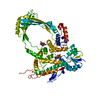
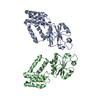

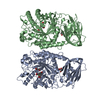
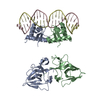
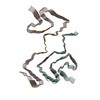

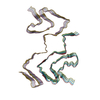
 PDBj
PDBj
